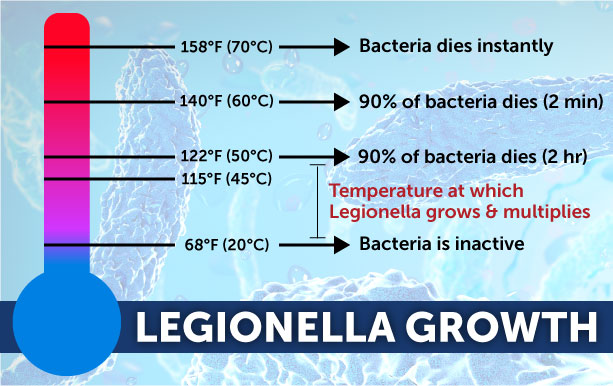A Practical Guide to Legionella Control in Water Systems
Since its discovery in the summer of 1976, Legionella bacteria has been an ever increasingly hot topic in the plumbing industry, seeming to lurk in pipes and water systems, waiting to strike in a moment of lapsed attention or vigilance.

According to Smithsonian Magazine, the CDC reports that as of 2018, cases of Legionnaires’ Disease, pneumonia caused by aspirating the Legionella bacteria, have risen significantly. With nearly 10,000 cases reported in 2018 alone, Legionnaires seems to be running rampant in modern water systems.
While some attribute the sharp rise in case numbers to improved reporting, awareness, and testing methods, it has also been suggested that aging infrastructure and climate change could be contributing factors.
Foundational Strategies for Legionella Mitigation
While prevalent in modern plumbing systems, Legionella bacteria only presents a risk when able to colonize, typically in stretches of piping with warm, stagnant water. For many buildings, simple changes to system design and management procedures can significantly reduce the prevalence of Legionella bacteria and inhibit growth before it can begin.
1. Avoid “Dead Legs” in Piping Design
Minimizing the distance between supply lines and fixtures in your system design can reduce areas of stagnation in the hot water piping which could accumulate scale and biofilm buildup, a prime location for Legionella bacteria to set up shop.
2. Maintain Water Temperature Control
Legionella bacteria flourishes in warm water with comfortable temperatures ranging from around 70°F to 115°F. Storing water at temperatures above 120°F will generally help prevent colonization.

To prevent bacteria growth, specify hot water tanks that store water above 140°F (60°C) and use a mixing valve to recirculate it to the fixtures at 120°F (48.9°C) to comply with anti-scalding regulations.
3. Ensure Constant Recirculation
Keeping your recirculation pumps running at all times will keep water flowing and prevent bacteria from grouping together and adhering to pipe walls.
4. Perform Routine Maintenance of Equipment
The CDC recommends cleaning water tanks routinely including periodically draining the system to remove scale and sediment. This will prevent biofilm, organic debris, and corrosion from contaminating your water system.
CircuitSolver Sanitary Flush Valve

For domestic hot water systems using a heat-and-flush thermal disinfection method to prevent Legionella bacteria growth, balancing during the flush is essential to ensure thorough sanitation.
CircuitSolver Sanitary Flush Valve utilizes two thermal actuators for automatic thermal balancing of the system; one for normal DHWS operation, and the other for thermal disinfection. Click here to see how it works.
